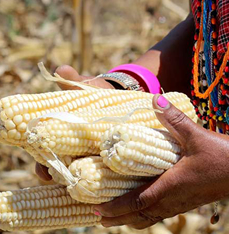Africa Can Feed Itself
 Surrounded by tangled shrubland, Wisdom Mababe’s farm in central Zambia seems incongruously neat. “In 2002, when I started, it was bare bush,” he says. Each year since, he has bulldozed an area the size of 40 football pitches. Maize grows in ordered rows; cattle graze behind a fence. “The land, the water, it’s in abundance,” he gushes. Beyond his fields, the tall grass waves.
Surrounded by tangled shrubland, Wisdom Mababe’s farm in central Zambia seems incongruously neat. “In 2002, when I started, it was bare bush,” he says. Each year since, he has bulldozed an area the size of 40 football pitches. Maize grows in ordered rows; cattle graze behind a fence. “The land, the water, it’s in abundance,” he gushes. Beyond his fields, the tall grass waves.
For most of its history, sub-Saharan Africa has been short of people, not land. In 2011 the World Bank estimated that the region had 200m hectares of suitable land that was not being used for crops—almost half of the world’s total, and more than the cultivated area of America. That potential excites many. “Africa is the future breadbasket of the world,” says Ephraim Nkonya of the International Food Policy Research Institute, a think-tank in Washington, DC.
Yet such aggregate figures may deceive. Most of Africa’s spare land lies in just a few big countries, such as Sudan and the Democratic Republic of Congo. In densely populated places (with more than 100 people per square kilometre of farmland), average farm sizes have shrunk by a third since the 1970s. The continent is already a net importer of food; by 2050 it may have twice as many bellies to fill. In hotspots like central Nigeria, clashes between crop-growing farmers and herders have killed thousands. Doom-mongers see a larger crisis brewing.
From Mr Mababe’s tranquil farm, such fears seem distant. Only a fifth of land in his district is being used, reckons the council chairman. A German company has bought 40,000 hectares of private land to grow maize and soya beans. The government is trying to lure other commercial outfits to designated “farm blocks” around a country twice as big as Germany, with fewer people than the Netherlands.
But even here, land is scarcer than it seems. The western half of the district is a national park. Locals complain that heavy-handed rangers on private game ranches stop them fishing and picking mushrooms. “This land we are in here, it’s not ours,” says one villager, “it’s for people who have money.” Human Rights Watch says that poor people in other districts are being evicted by commercial farms.
Despite talk of Africa’s unused land, few places are truly empty. “On a map it is like that,” says Mbumwae Nyambe, a paralegal with the Catholic Church. “But when you go in the field you find there are already people there.” Uncultivated land is used for grazing, foraging or hunting. Occupiers are often surprised to hear themselves labelled as squatters. In northern Uganda people returning home after being displaced by war found their “empty” fields had been dished out among generals, tycoons and conservationists.
Perhaps a tenth of Africa’s cultivated land is now in the hands of big business, which uses most of it for biofuels, timber and other non-food crops. As significant is the rise of mid-size farms (those between five and 100 hectares), often owned by civil servants in the cities. “They have the political connections,” says Thomas Jayne of Michigan State University. Many are not serious farmers. Those who own more than 20 hectares often leave most of it idle.
Middling farms now cover more of Zambia than small ones. Meanwhile squeezed smallholders farm their shrinking plots too intensively, degrading already poor soils. This happens even in spacious countries because people are concentrated along roads and in towns. Africa has enough land why is it so hard to feed itself?
This presents a conundrum. Better seeds and fertiliser, as well as niftier techniques, could send Africa’s farm yields soaring. But mechanised commercial farms do not provide as many jobs as subsistence agriculture. Most Africans still live in the countryside. That life there is so tough is why they are abandoning it faster than people on any other continent.